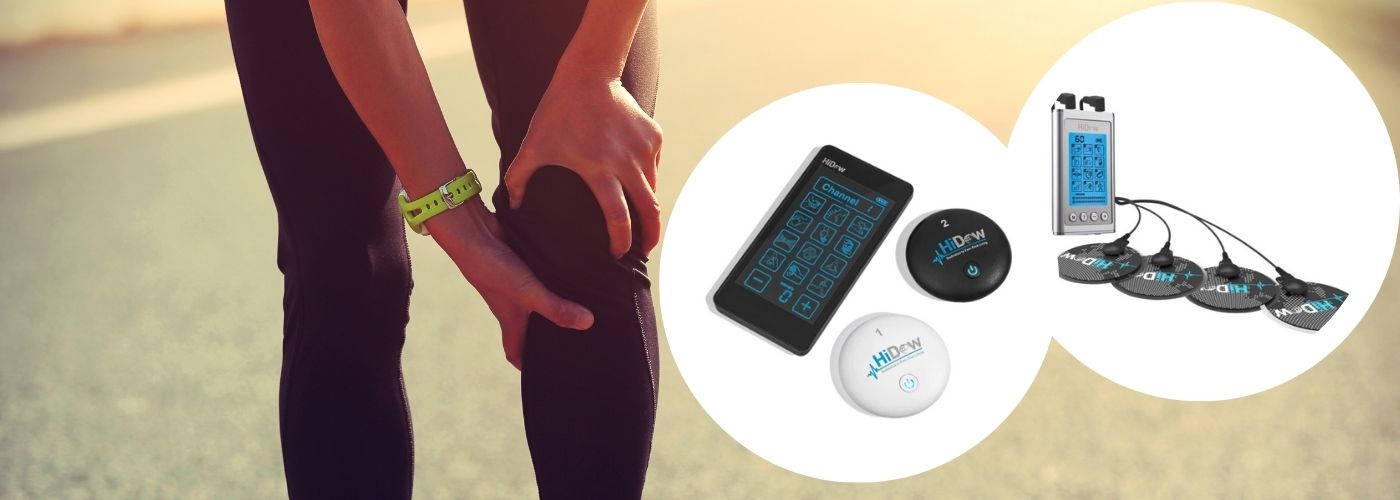Knee pain is a debilitating condition that impacts millions globally, limiting mobility and affecting quality of life. Amidst various treatment options, TENS units for knee pain shine as a beacon of hope. This guide delves into the science of TENS therapy, offering insights into its effectiveness for knee pain relief, practical usage tips, and how it stands as a non-invasive alternative to traditional pain management methods.
How To Use A TENS Unit For Knee Pain
When using a TENS unit for knee pain, it’s important to first identify the correct placement of the electrodes.
For knee pain, placing the electrodes on either side of the kneecap or above and below can be effective. Start with a low-intensity setting and gradually increase until reaching a comfortable level that provides pain relief without causing discomfort.
Using a TENS unit consistently for short periods throughout the day can help manage chronic knee pain effectively.
Another tip is to experiment with different electrode placements and settings to find what works best for your individual needs. Don’t be afraid to explore various options and adjust accordingly based on your pain levels.
Additionally, incorporating gentle movement or exercises while using the TENS unit can further enhance its effectiveness in reducing knee pain. Remember, consistency is key when using a TENS unit for knee pain – so make it a regular part of your routine for lasting relief.
Does Exercising With A TENS Unit Help Knee Pain?
Exercising with a TENS unit can be a game-changer for individuals suffering from knee pain. The electrical stimulation provided by the TENS device can help reduce pain signals sent to the brain, allowing for improved range of motion and function during exercise.
This means that individuals are more likely to engage in physical activity, which is crucial for maintaining overall knee health.

Moreover, using a TENS unit during exercise can also help promote muscle strength and endurance in the surrounding muscles of the knee joint. By targeting specific areas with electrical impulses, users can strengthen weak muscles and improve stability in the knee, ultimately reducing the risk of further injury or pain.
Incorporating a TENS unit and knee wrap into an exercise routine not only provides immediate pain relief but also long-term benefits for overall knee health and functionality.
What Are Good TENS Units For Knee Pain?
Two popular TENS units known for effectively combating knee pain are the HiDow Pro Touch 6-12 and the HiDow XPD 12.
The wireless Pro Touch 6-12 offers a customizable experience with various intensity levels and massage modes to target specific areas of discomfort in the knee joint.
This tens unit for knee pain stands out for its wireless capabilities and long battery life. Overall, making it a great choice for many!

On the other hand, the XPD 12 stands out for its portability, making it convenient for users to alleviate knee pain on-the-go.
Both devices utilize cutting-edge technology to deliver targeted electrotherapy that stimulates muscles and nerves, providing relief from knee pain. Users have reported significant improvements in their condition after incorporating these TENS units into their daily pain management routine.
Whether you prefer the versatility of the Pro Touch 6-12 or the convenience of the XPD 12, both devices offer an effective and non-invasive solution for addressing knee discomfort.
How Often To Use TENS Units For Knee Pain
When it comes to using TENS units for knee pain, the frequency of use can vary depending on individual needs and preferences. Many experts recommend using a TENS unit for knee pain 2-3 times per day for 20-30 minutes each session.
This frequency has been found to provide effective pain relief and promote healing without overstimulating the muscles or causing discomfort.
However, some users may find that they need more frequent sessions, especially during flare-ups or periods of increased pain. It is important to listen to your body and adjust the frequency of TENS unit use accordingly.
Experimenting with different frequencies can help you find the optimal schedule that provides the best results for your specific knee pain condition. Remember to consult with a healthcare professional before starting any new treatment regimen for knee pain, including the use of a TENS unit.
Where To Place TENS Unit Pads For Knee Pain
When it comes to placing TENS unit pads for knee pain, precision is key. To effectively target the pain, it’s recommended to place one pad above the knee on the quadriceps muscle and the other pad below the knee on the calf muscle.
This positioning ensures that electrical stimulation reaches both sides of the knee joint, providing comprehensive pain relief.
Another effective placement for TENS unit pads is above and below the kneecap in a vertical orientation. This placement targets both the front and back of the knee, allowing for greater coverage of pain relief.
Experimenting with different pad placements can help individuals find what works best for their unique needs and maximize the benefits of TENS therapy for knee pain relief.
For those experiencing knee pain in a specific area, placing one pad directly on either side of the painful area can provide targeted relief. By adjusting placement slightly depending on where your specific discomfort lies, you can tailor your TENS therapy to address your individual needs effectively.
Benefits Of TENS Units For Knee Pain
TENS units offer a non-invasive and drug-free solution for managing knee pain, providing relief through electrotherapy.
By targeting the nerves in the affected area, TENS units can effectively alleviate discomfort and improve mobility. This approach is especially beneficial for those looking to avoid or reduce their reliance on pain medications, offering a safe and alternative method to address knee pain.

Additionally, using a TENS unit may enhance blood circulation in the knee area, helping to reduce inflammation and promote healing. The gentle electrical pulses from the device can also stimulate endorphin release, acting as natural painkillers that further alleviate discomfort.
This dual action of increasing blood flow and releasing endorphins not only provides immediate relief but also supports long-term healing of the knee joint.
Side Effects When Using A TENS Unit
While TENS units are generally safe and effective for managing pain, there can be some potential side effects to be aware of.
One common side effect is skin irritation or redness at the electrode placement site. This can usually be minimized by ensuring proper electrode placement and using clean pads.
Another possible side effect of using a TENS unit is muscle twitching or spasms, especially if the intensity of the electrical stimulation is too high.
It’s important to start with a lower intensity level and gradually increase it to the most comfortable level for you.
Additionally, some people may experience mild headaches or dizziness during or after using a TENS unit, which could be due to overstimulation of nerves.
Overall, it’s essential to use a TENS unit properly and follow manufacturer guidelines. Generally, using a TENS unit is safe under the approval and supervision of your medical doctor.
If you experience any persistent or concerning symptoms while using a TENS unit, it’s important to consult with your healthcare provider for further guidance on adjusting your treatment plan.

Related Stories
Red, White, and Soothe: How HiDow Helps You Recover in the Heat
Recovery that works in winter doesn’t always hold up in the heat. The body reacts...
Jul
Massage Gun Showdown: How the Power Duo Compares to Traditional Methods
Have you ever considered that a handheld device could revolutionize your muscle recovery? With the...
Jun
Fatherly Fitness Tips For Men’s Health Month
Men’s Health Month is more than a date on the calendar—it’s a call to action....
Jun
Built to Move: The Everyday Recovery Edit
Movement is what keeps us going—literally. Whether it’s recovering after a run, loosening up after...
Jun
Unlocking The Secret To Tissue Injury Recovery With TENS/EMS Devices
Have you ever wondered why some injuries take longer to heal than others? Tissue injuries...
May
Get Mobile With HiDow TriggerFlex Tools & TriggerFlex 2.0
Tight muscles holding you back? Whether you’re dealing with daily tension or post-workout soreness, recovery...
May